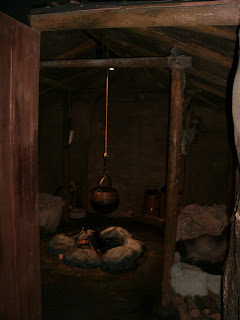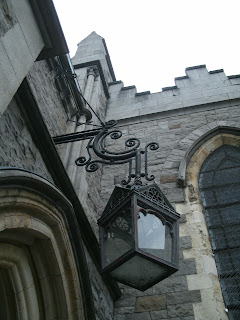Unweit vom Dublin Castle befindet sich Christ Church Cathedral, die ältere der beiden mittelalterlichen Kathedralen Dublins, ursprünglich erbaut von den Wikingern als Holzkirche 1038; die Steinkirche wurde von Richard de Clare, Earl of Pembroke und dem Erzbischof Laurence O'Toole um 1170 in Auftrag gegeben und ca 1240 fertig gestellt, anfangs römisch-katholisch, nach Heinrich VIII. Lossagung von Rom gehört sie zur Church of England, heute Church of Ireland. Unter Elisabeth I.wurde hier erstmals die Messe in englisch gehalten, kurzfristig kehrte man zur alten Liturgie zurück als James II., der nach Irland geflüchtete katholische englische König hier ein bisschen herrschte, aber nachdem er gegen William von Oranien den Thron verlor, kehrte die Kirche zur anglikanischen Messe zurück. Es tagten auch Gericht und Parlament hier, bis beide Institutionen schließlich in andere Gebäude umsiedelten. Die Kirche war berühmt für ihren Chor, der auch an der Uraufführung des "Messias" von Händel mitwirkte.
In viktorianischer Zeit verfiel die Kirche zusehends, das Kirchenschiff drohte einzustürzen, gerettet wurde sie durch eine private Spende und dadurch umfassend saniert und erweitert, schwer zu sagen, was an Bausubstanz aus dem Mittelalter stammt und was aus dem ausgehenden 19. Jh.
Gleich nebenan, im ehemaligen Bischofssitz befindet sich das Museum Dublinia, ein Querschnitt durch Dublins Früh - und Mittelalter, sehr anschaulich, aufwändig, unterhaltsam.
Tickets gibt´s im Doppelpack, also 2 zum Preis von 2, und los geht´s: zu den Wikingern, ins Mittelalter, zu den Archäologen, die vergrabenes an´s Licht bringen und dann in die Kirche, wo es auch heute noch wenig Licht gab...
Not far from the Dublin Castle there is Christ Church Cathedral, the elder of the medieval cathedrals of Dublin, founded by the Vikings 1038 as a wooden church, the stonechurch was commissioned by Richard de Clare, Earl of Pembroke and the archbishop Laurence O'Toole in 1170 and was finished around 1240, in the beginning roman-catholic, after Henry VIII. declared his renunciation from Rome it belonged to the Church of England and today to the Church of Ireland. Under the reign of Elisabeth I. first time the Mass was hold in english language. For a short time they went back to the latin liturgy when James II., catholic english king who fled to Ireland, did rule here a bit, but after he lost his throne to William of Oranien, the church went back to the english Mass. Also court and parliament sat here, before they move to diffent places. The choir of the church took part in the premiere of the "Messias" by Handel.
In victorian age the church was getting ruined, the nave impants to collapse, the building could be save by a private donation and so a lot of reconstration and rebuilding was done. Hard to tell today wich parts remains from the middle age and wich from the end of the 19th century.
Near by, in the former bishops house is the Museum Dublinia, where one gets an overlook over the Viking and medieval ages of Dublin, very vivid, elaborate, entertaining.
Ticket were given away as twin pack, two for the price of two and here we go: to the Vikings, into the dark age, to the archaeological team, who brings back to the light what was hidden and than into the church, where there is still a lack of light....















































Keine Kommentare:
Kommentar veröffentlichen